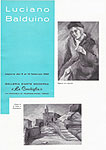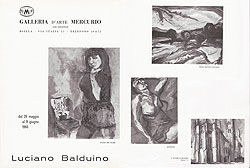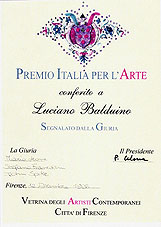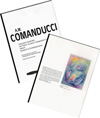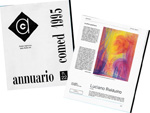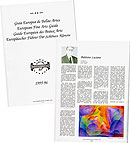|
Critical Essay
Luciano Balduino always talks with the colour of spiritual heat. He transforms the silence of his own conscience into a progressive evocation, which then transfigures into sweeping and harmonious brush strokes. This means that his inner soul is never disturbed, but in a state of silent ecstasy which produces a colourful magic. This poet brings images, most definitely not born from a predetermined decision but instead from unconscious gestural expressions, from the palette to the surface.[…].
 |
| Arte Moderna numero 35 |
Each one of his compositions is like the first day of the creation as represented in the book of Genesis. From the chaos of many colours blending together on his pallet, comes the miracle of distinguishing between being and appearing, between what is abstract and the earthly substance. It is about a painter who has a talent to express his own inspirations through graceful lines transparent like those of watercolours, which suddenly create undefined figures. These differences are what make him a painter aiming towards the high spirit.Ciò significa che il suo animo interiore non è mai turbato, ma in estasi nel proprio silenzio che produce magie cromatiche. Dalla gestualità inconscia di questo poeta della tavolozza giunge in superficie un apparire di immagini che, certamente, non nascono da una decisione preordinata. [...]
Ogni sua composizione è, per lui, il primo giorno rappresentato nel Libro della Genesi. Dal caos del magma della tavolozza giunge il miracolo della distinzione tra l'essere e l'apparire, tra l'astrazione e la sostanza terrena. Si tratta di un pittore che ha la dote di esprimere le proprie illuminazioni tramite sprazzi figurali, improvvisi, dalla stesura garbata, trasparente come quella dell'acquerello. Sono proprio queste trasparenze che fanno di lui un pittore teso verso lo Spirito alto.
Paolo Levi
CATALOGO DELL’ARTE ODERNA No.35 (Ed.
Giorgio Mondadori)
[…]In Balduino’s opinion, colour must awaken sensations in the field of art, which go beyond aesthetic beauty; this means that he doesn’t forget that a painting is also a language to communicate with others.
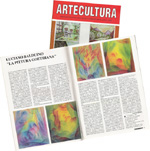 |
| ArteCultura |
From this idea is born something undefined, a sort of visionary magic […], which in the thoughts of the artist interposes itself between the identity of essence and the identity of existence. Hints of virtual shapes appear as a result of this spontaneous sensation. […]At the same time the shaded and meaningful images are like sudden revelatory brainwaves, a result of sudden flashes of inspiration that speak with spiritual suggestions to our souls. In short, this is the painting of Balduino.
Franco Passoni
ARTECULTURA – Milano Marci 1996
Accompanied by the analysis of qualified art critics, the work of Luciano Balduino reveals a will to communicate, to entrust the expression of his own complex interiority and profound sense of existence to colour and to the appearance of shapes.
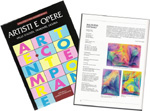 |
| Arte contemporanea |
From the strong energy of colour comes a way of painting made more precious by the atmospheric lights, which penetrate into the material and give it life. His pictorial pages are characterised by the solar predominance of yellow, by the vital strength of red and by hints of green. These colours suggest a large range of works, which led Franco Passoni to say, “They are shaded images…which are like revelatory brainwaves”, like signs from our time.
Angelo Mistrangelo
ARTISTI E OPERE, vol.
II (Ed. Giorgio Mondadori)
[…The “Theory of colours” by Goethe is the main contributing essay to colour to which the painter Luciano Balduino uses to inspire his own pictorial work. It in fact, proceeds from the observations that colour, with its own intrinsic vitality, is animated by peculiar tensions. From the bright nature and wide range of tones descends the deepest and most authentic mould of an image. This image as stated concisely by Balduino “… completely expresses the potential chromatic contents and is a means to talk to the essence of man.”
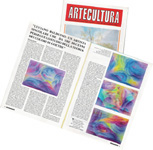 |
| ArteCultura |
Carefully examining the painter’s work, you can observe, first of all, the intense transparency of light, noticeably diaphanous and dynamic in its infinite and multiple radiations and it is really these very fine interlacements of bright impulses which visibly create the represented image and give it a lyrical and strong consistency.
Shape, in Balduino’s paintings, is subjected to a deep, constant genetic evolution of light that is divided into an infinite mixture of tones, from which the physical and optical contact receives the enlivening strength of the representation.
Balduino’s expressive language is presented as quite original in his artistic proposal as well as in the cultural and psychological motivations, which represent its theoretical foundation. […] The visual and conceptualise message of Balduino’s artistic research is very personal and pervaded by peculiar motives of creative inspiration. This is expressed in his congenial articulation of “Themes of Colour” and will provoke new and more stimulating questions about the imaginative planning of this artist and his profound personality as the insightful protagonist of Art and its mystery. It is a work well worth knowing and following.
Teodosio Martucci
ARTECULTURA – Milan, January 1995
[…]The picturesque works of Luciano Balduino are bewitching as they reach towards the heart and speak the magic language of colour. They are able to awaken unique and defined sensations. […]
The chromatic forms, which emerge from his compositions, are possessors of worth and of symbols that in every moment question the sacredness of human being and existence. […].
The great aspiration of this art is high, it tends to recreate an Arcadia of the spirit and to give them life; Luciano Balduino unifies universally retained values to primitive instinctual classics and to the strength and living nature of sensations.
Anna Iozzino
“FORUM ARTIES”, Contemporary International Magazine – Modena, April 1999
Numerous critics have written about him:
Marziano Bernardi, Angelo Dragone, Anna Iozzino, Paolo Levi, Teodosio Martucci, Antonio Oberti, Franco Passoni, Ottavio Rossani, Marisa Vescovo and several others.
|




